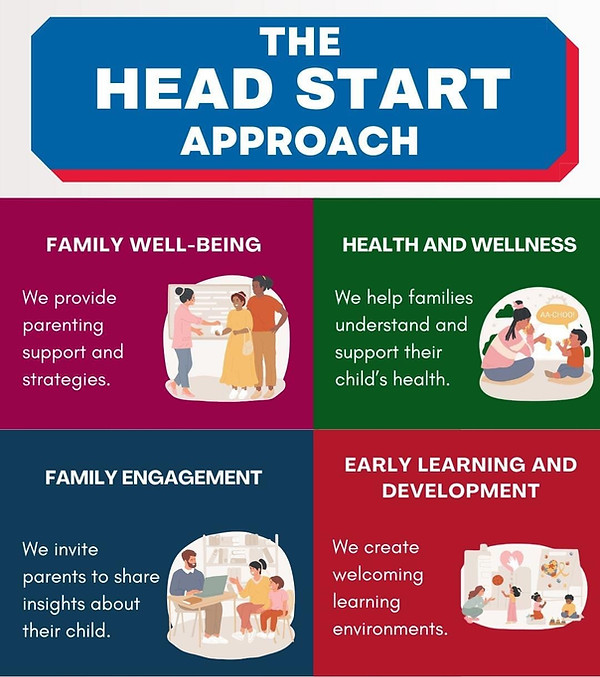
What is Head Start?
Head Start is a federal program authorized by the Improving Head Start for School Readiness Act of 2007.
Head Start and Early Head Start programs in local communities support the mental, social, and emotional development of children from birth to age 5. In addition to education services, programs provide children and their families with health, nutrition, social, and other services. Head Start services are responsive to each child and family's ethnic, cultural, and linguistic heritage.
Head Start encourages the role of parents as their child's first and most important teachers. Programs build relationships with families that support positive parent-child relationships, family well-being, and connections to peers and community. Head Start began as a program for preschoolers. Three- and 4-year-olds made up over 80 percent of the children served by Head Start last year.
Early Head Start serves pregnant women, infants, and toddlers. Early Head Start programs are available to the family until the child turns 3 years old and is ready to transition into Head Start or another pre-K program. Early Head Start helps families care for their infants and toddlers through early, continuous, intensive, and comprehensive services.
More information is at the Office of Head Start website: http://eclkc.ohs.acf.hhs.gov/hslc/hs/about
What is Head Start?
On May 18, President Lyndon B. Johnson officially announced Project Head Start. Head Start launched that summer, serving more than 560,000 children and families across America in an eight-week summer program.
1965


Home Start began to provide Head Start services to children and parents in their own homes. A permanent program option was eventually added, and is called "Home-Based."
1973

The Head Start Bureau published a Handbook for Local Head Start Nutrition Specialists that set the nutrition guidelines for all Head Start programs.
1983
Head Start issued the nation's first official regulation on the transportation of preschool children. This regulation governs how grantees transport children to and from program activities.
2001
Congress launched the Early Head Start-Child Care Partnership Grants.
2014
1966
1970
1975
1994
2007
2020
Based on the success of the summer program, Congress authorized Head Start as a primarily part-day, nine-month program.
Parent involvement started being required through Parent Committees, Policy Committees and Policy Councils.
Head Start published the first set of performance standards that detail guidelines for serving children ages 3 to 5.
Early Head Start was created, establishing services for pregnant women, infants, and toddlers.

Congress passed the The Improving Head Start for School Readiness Act.
Coronavirus disease 2019 (COVID-19) deeply affected Head Start and Early Head Start programs, enrolled children and families, and communities. Most programs stopped in-person services, offering instead a mix of virtual or remote child development services, combined with other family supports.
Head Start is a federal program authorized by the Improving Head Start for School Readiness Act of 2007.
Head Start and Early Head Start programs in local communities support the mental, social, and emotional development of children from birth to age 5. In addition to education services, programs provide children and their families with health, nutrition, social, and other services. Head Start services are responsive to each child and family's ethnic, cultural, and linguistic heritage.
Head Start encourages the role of parents as their child's first and most important teachers. Programs build relationships with families that support positive parent-child relationships, family well-being, and connections to peers and community. Head Start began as a program for preschoolers. Three- and 4-year-olds made up over 80 percent of the children served by Head Start last year.
Early Head Start serves pregnant women, infants, and toddlers. Early Head Start programs are available to the family until the child turns 3 years old and is ready to transition into Head Start or another pre-K program. Early Head Start helps families care for their infants and toddlers through early, continuous, intensive, and comprehensive services.

Peter Masters conceptualized the National Head Start logo in 1965.
-
He used building blocks (common play toys and learning tools) as a metaphor for the development and growth of children through Head Start.
-
To reflect the fact that Head Start is a national program operated by the Government, Masters added a representation of the American flag by using red and white stripes and an arrow, printed in reverse on a blue background.
-
The arrow pointing upward represents the direction out of poverty and on to the future.
-
The two squares represent early childhood by suggesting building blocks.
-
The arrangement of the blocks represents stairs by which this can be accomplished.
-
The vertical stripes represent the child and parent.





